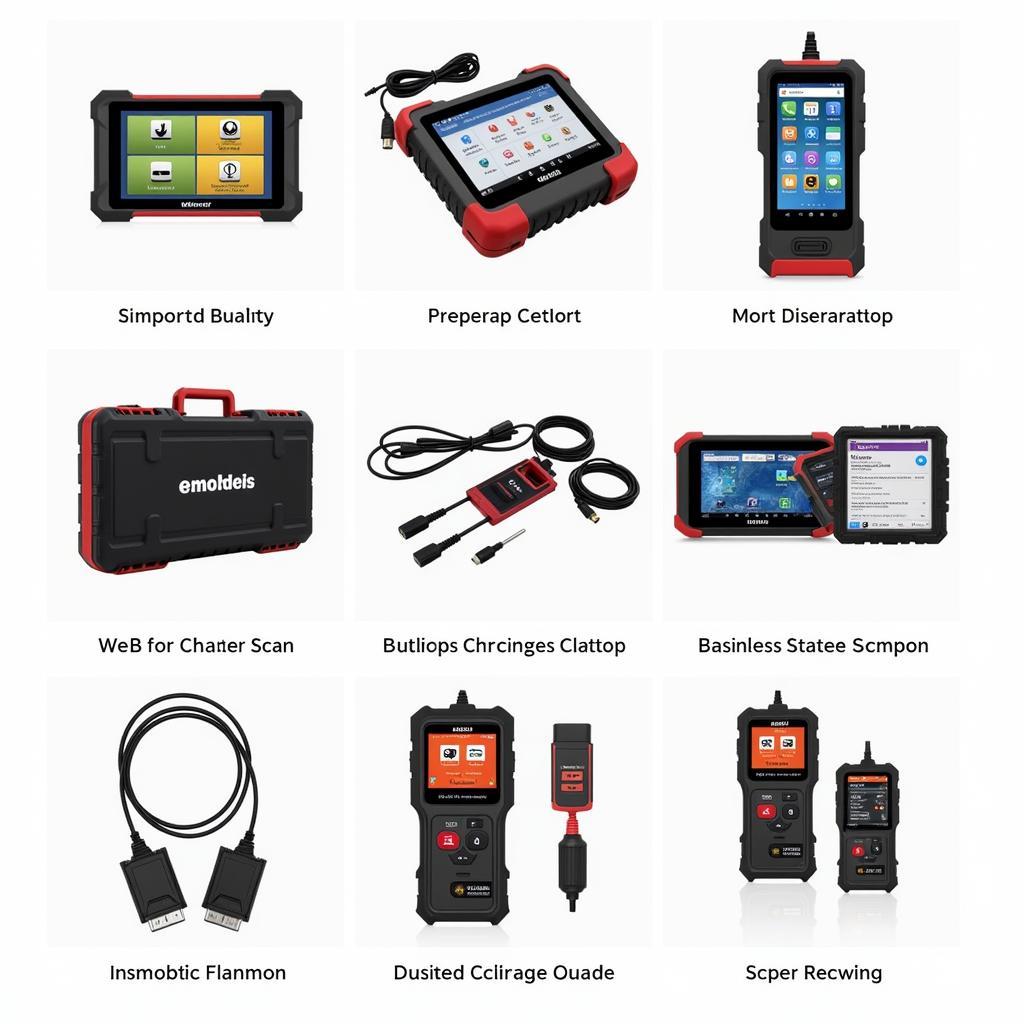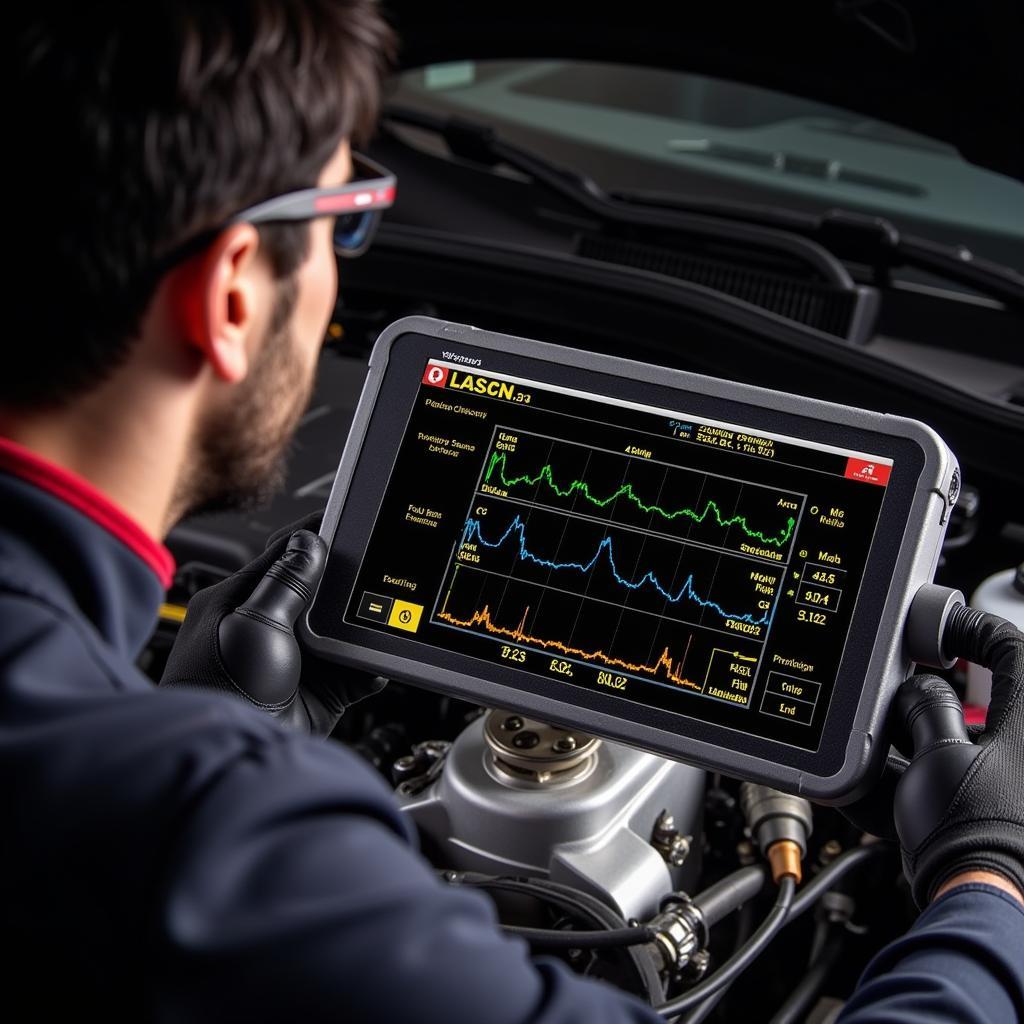An Hvac System Calibration Scan Tool is an essential piece of equipment for any mechanic or car owner who wants to diagnose and repair air conditioning issues in their vehicles. These sophisticated tools allow you to read and clear diagnostic trouble codes, monitor live data streams, and perform crucial calibrations to ensure your HVAC system is running at peak performance.
What is an HVAC System Calibration Scan Tool?
An HVAC system calibration scan tool is an electronic device that connects to your vehicle’s onboard diagnostic port (OBD-II) to communicate with the HVAC control module. This allows the tool to access a wealth of information about your car’s air conditioning system, including:
- System pressures and temperatures: The scan tool can display real-time data on refrigerant pressure, evaporator temperature, and other crucial parameters, helping you identify leaks, blockages, or other problems.
- Actuator and sensor performance: You can use the tool to test the functionality of HVAC components like blend door actuators, compressor clutches, and temperature sensors.
- Diagnostic trouble codes (DTCs): When the HVAC system detects a malfunction, it stores a DTC in the control module’s memory. The scan tool can retrieve and display these codes, providing valuable clues about the nature of the issue.
- Calibration and programming functions: After replacing HVAC components, you might need to recalibrate the system or program new parts. A scan tool with bi-directional capabilities can help you perform these tasks.
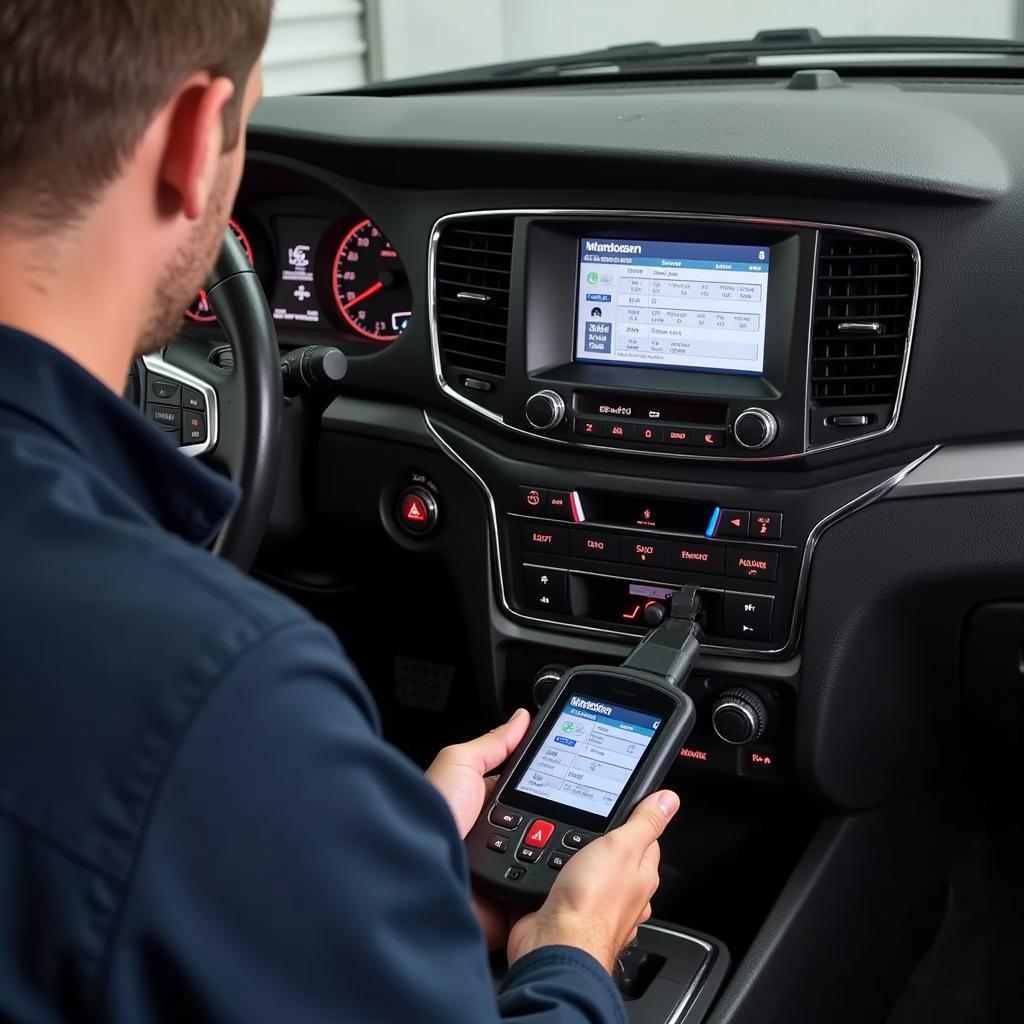 HVAC scan tool performing vehicle diagnostics
HVAC scan tool performing vehicle diagnostics
Why Do You Need an HVAC System Calibration Scan Tool?
While simpler problems might be diagnosed with basic tools, more complex issues require a dedicated scan tool for accurate diagnosis and repair. Here are some key benefits:
- Accurate diagnosis: HVAC problems can stem from various sources, making it challenging to pinpoint the root cause. A scan tool provides precise data and DTCs, eliminating guesswork and saving you time and money.
- Advanced troubleshooting: The ability to monitor live data streams lets you observe system behavior in real-time, helping you identify intermittent issues or verify repairs.
- Comprehensive repairs: Modern vehicles rely heavily on electronic controls. An HVAC scan tool allows you to perform calibrations, programming, and component activations, ensuring comprehensive repairs.
- Cost savings: By enabling accurate diagnosis and repair, you can avoid unnecessary part replacements and repeat visits to the mechanic.
How to Choose the Right HVAC Calibration Scan Tool
Choosing the best HVAC scan tool can feel overwhelming with the vast array of options available. Consider these factors when making your decision:
- Vehicle compatibility: Ensure the scan tool is compatible with your car’s make, model, and year. Some tools specialize in specific vehicle brands, while others offer broader coverage.
- Functionality: Determine the features you need, such as live data streaming, DTC reading and clearing, calibration functions, and bi-directional control.
- User interface: Choose a tool with a user-friendly interface, intuitive menus, and clear instructions.
- Software updates: Regular software updates ensure compatibility with new vehicle models and functionalities. Opt for a tool with a reliable update mechanism.
- Budget: Prices vary depending on features and capabilities. Define your budget and choose the best tool that aligns with your needs and financial constraints.
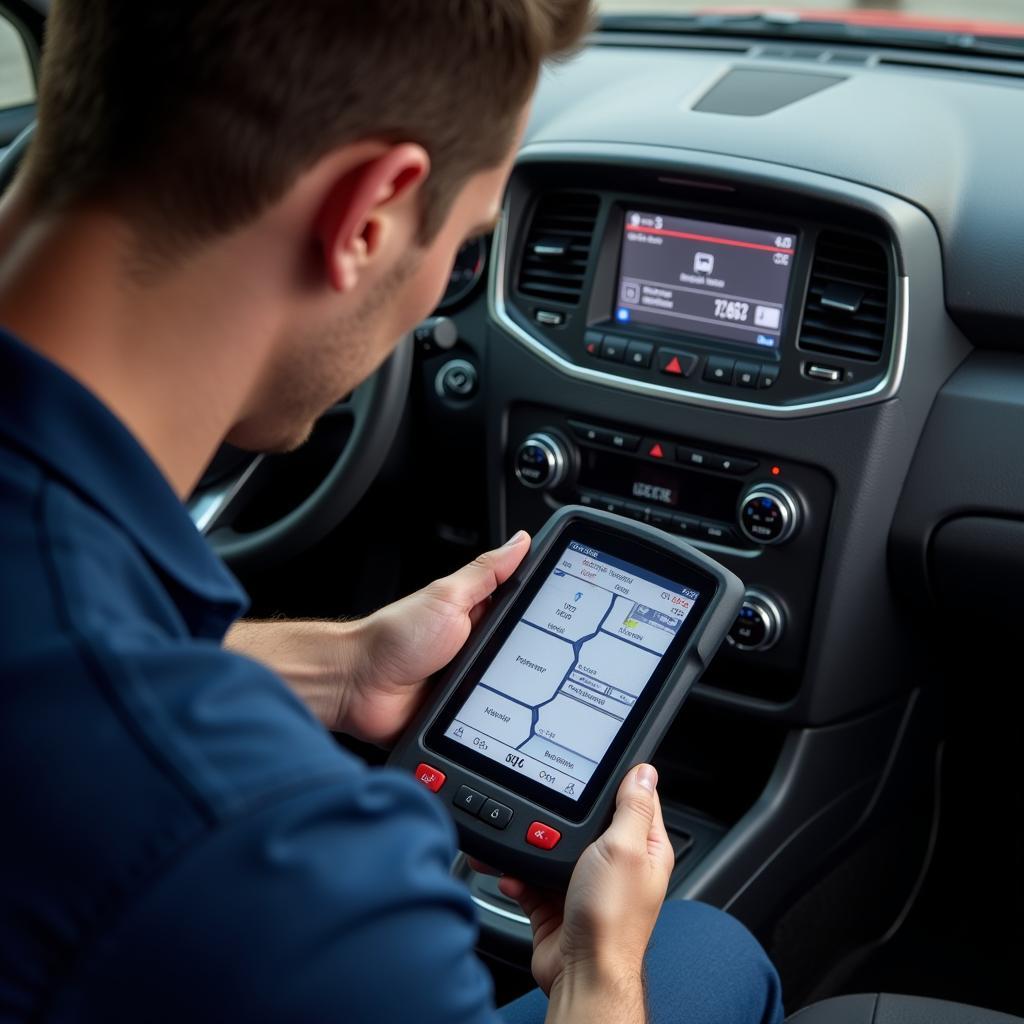 Mechanic using scan tool for car AC repair
Mechanic using scan tool for car AC repair
Common Uses of HVAC System Calibration Scan Tools
HVAC system calibration scan tools have become indispensable for professional mechanics and knowledgeable DIY enthusiasts. Here are some common applications:
- Refrigerant Leak Detection: The scan tool can monitor pressure readings to pinpoint refrigerant leaks, allowing technicians to locate and repair leaks efficiently.
- Compressor Functionality Testing: By commanding the compressor clutch on/off, the scan tool enables mechanics to verify the compressor’s operation and identify potential electrical or mechanical issues.
- Blend Door Calibration: After replacing a blend door actuator, a scan tool allows you to recalibrate the door’s position, ensuring accurate temperature control and airflow distribution.
- Sensor Diagnosis and Replacement: The tool can retrieve data from temperature, pressure, and position sensors, helping diagnose faulty sensors and ensure proper function after replacement.
Tips for Using an HVAC System Calibration Scan Tool
- Consult your vehicle’s service manual: The service manual provides essential information about your HVAC system’s components, wiring diagrams, and diagnostic procedures.
- Start with a visual inspection: Before using the scan tool, visually inspect the HVAC system for any obvious damage, loose connections, or debris.
- Connect the scan tool properly: Ensure the scan tool is securely connected to the vehicle’s OBD-II port and powered on.
- Interpret DTCs carefully: Use the scan tool’s built-in code library or a reliable online resource to understand the meaning of each DTC.
- Record data and observations: Note down relevant data, such as DTCs, live data readings, and symptoms, to aid in diagnosis and repair.
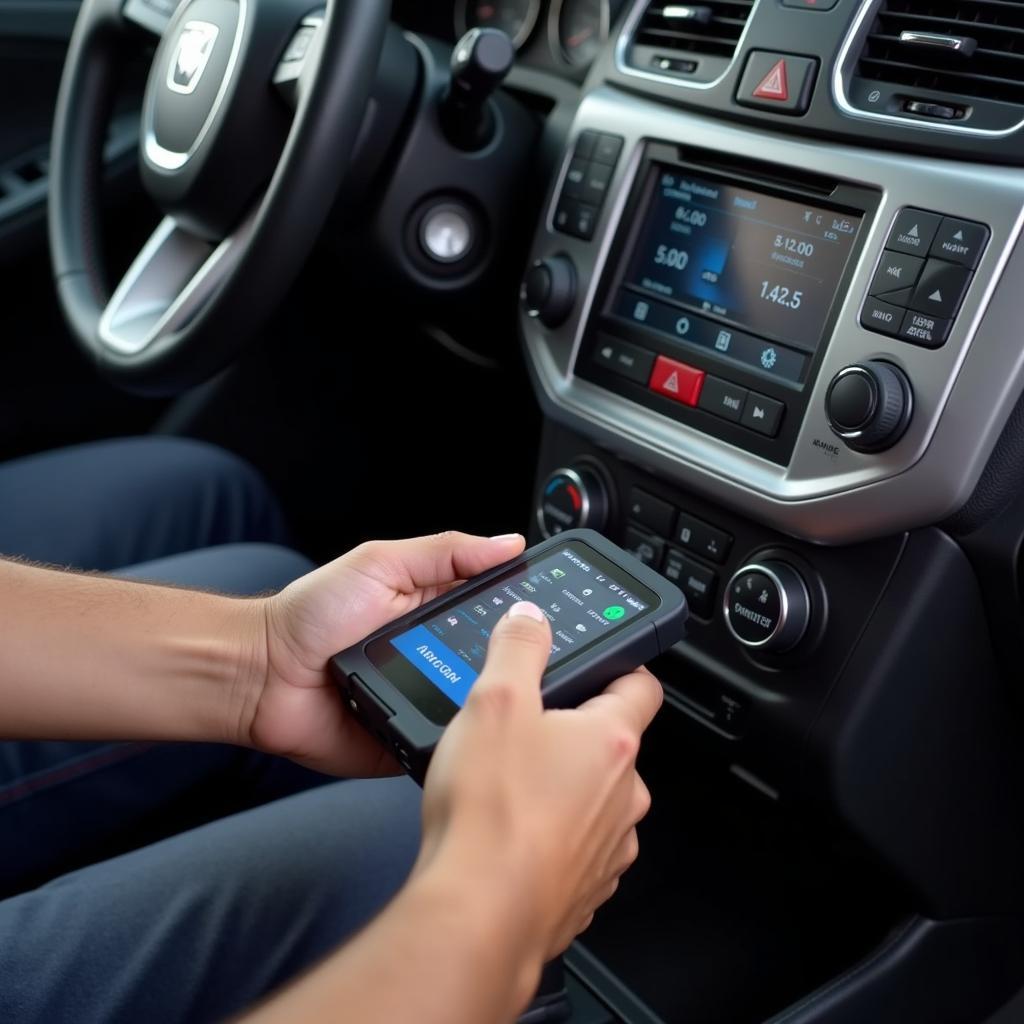 Mechanic connecting HVAC scan tool for car AC diagnostics
Mechanic connecting HVAC scan tool for car AC diagnostics
Expert Insights
“Investing in a quality HVAC scan tool is crucial for any serious automotive workshop,” says John Miller, a seasoned automotive electrician with over 20 years of experience. “It allows us to accurately diagnose and repair even the most complex AC issues, saving our clients time and money.”
“For car owners who prefer DIY repairs, a user-friendly scan tool can be a game-changer,” adds Emily Carter, a certified automotive technician and DIY enthusiast. “It empowers you to understand your car’s HVAC system and perform many repairs yourself.”
Conclusion
An HVAC system calibration scan tool is an essential tool for diagnosing and repairing modern vehicle air conditioning systems. Whether you’re a professional mechanic or a dedicated car enthusiast, investing in a quality scan tool can save you time, money, and frustration. By understanding the functions, benefits, and selection criteria, you can choose the best tool for your needs and keep your car’s HVAC system running smoothly.
If you need assistance choosing the right HVAC system calibration scan tool for your needs, our experts at ScanToolUS are here to help. Contact us at +1 (641) 206-8880 or visit our office at 1615 S Laramie Ave, Cicero, IL 60804, USA.
FAQs
1. Can I use any OBD-II scan tool for HVAC diagnostics?
No, while most OBD-II scan tools can read and clear engine-related codes, they might not have the functionality to diagnose and calibrate HVAC systems. You’ll need a dedicated HVAC system calibration scan tool or one with comprehensive functionalities.
2. Is it difficult to use an HVAC scan tool?
Modern HVAC scan tools come with user-friendly interfaces and intuitive menus. However, some technical knowledge about automotive HVAC systems is helpful for interpreting data and performing advanced functions.
3. Can I damage my car by using an HVAC scan tool incorrectly?
While it’s unlikely to cause severe damage, it’s essential to use the scan tool responsibly and follow the manufacturer’s instructions. Avoid altering settings you’re unsure about and consult your vehicle’s service manual if needed.
4. How often should I calibrate my car’s HVAC system?
Calibration is generally only needed when replacing specific HVAC components, such as blend door actuators or sensors. Consult your vehicle’s service manual or a trusted mechanic for guidance.
5. Are there affordable HVAC scan tools available for DIYers?
Yes, several affordable HVAC scan tools cater specifically to DIYers. These tools often offer essential functionalities like DTC reading, clearing, and basic live data streaming at a budget-friendly price.

